- The Cathedral of Santiago de Cuba
 Read more
Read moreThe Cathedral of Santiago de Cuba stands in the city’s center, a watchful and still grand witness to the struggles, dreams, and prayers of Cubans. Santiago de Cuba, 2016.
- Walking Around Santiago
 Read more
Read moreLike most first-time visitors to eastern Cuba, I was surprised at how mountainous and hilly the ancient colonial city of Santiago is. These stairs, built and restored many times since the city’s founding, ease the burden and prevent erosion and ...
- Havana from the Heavens
 Read more
Read moreThe sight of Havana from an approaching plane reveals the grids and patterns of historic urban planners. While the colonial quarter and iconic tourist hotels hug the coast, much of the interior combines the visions of 1940s and 1950s developers ...
- “My God is Real”
 Read more
Read moreRaúl Castro’s legalization of hundreds of entrepreneurial jobs and services after 2009 gave their owners an unexpected canvas on which to display their personal slogans, rather than the Communist Party’s mantras, which pervade urban and rural landscapes. This bicitaxi [bicycle ...
- Storytime in Cuba
 Read more
Read moreCubans’ national pastime is storytelling and talking—not baseball, in my view! Here, my son and his island cousins listen intently to UF Gator and now UC-Irvine professor of Caribbean History, Genesis Lara, as she prepares to read them a story ...
- Plaza de Armas, Santiago de Cuba
 Read more
Read moreAt the left of Santiago’s historic plaza stands the oldest building constructed by the Spanish in Latin America: the home of Cuba’s first Governor, Diego Velázquez. The house dates from 1515. Four years earlier, he had returned to the island, ...
- “We Continue to Defend the Revolution”…Really?
 Read more
Read moreFor decades now, Communist Party slogans like this one have been plastered on city walls and maintained by a local Committee for the Defense of the Revolution. Since 2019, when Raúl Castro yielded the top civilian posts of rule to ...
- Forest of Flag Poles
 Read more
Read moreBuilt to block the façade of the US Interests Section (now recast as the US Embassy), the “forest of flags” Fidel Castro had erected in 2006 had become a forest of empty flag poles ten years later. Black in color ...
- Driving on the Malecón
 Read more
Read moreTaken from a bike, this Sunday afternoon scene on Havana’s main thoroughfare captures the traffic-free, slower pace of life and breeze-cooled beauty of El Malecón, the long sea wall that defines this city. Havana, 2016.
- Lessons in Dance
 Read more
Read moreReady to take the stage by storm, sisters Alicia and Isabela pose in their formal costumes for a recital at the Sociedad Cultural Rosalía de Castro, which operates a restaurant but also offers Spanish dance classes to Cubans of all ...
- Fans of Cuba
 Read more
Read moreWhenever I visited my goddaughters Isabela and Alicia at the height of summer, playing dress-up and putting on makeup always required cranking up the “manual AC”, that is, a locally crafted and painted Cuban fan. Made to be used and ...
- Gato Tuerto (One-Eyed Cat)
 Read more
Read moreThis intimate nightclub, a place where local Cubans always outnumbered tourists in the pre-1959 era, is located directly across from Havana’s famed Hotel Nacional. While researching my book on the 1940s and 1950s, I could not resist witnessing its late-night ...
- Crystal Clear
 Read more
Read moreThe waters of Playa Girón, in south-central Cuba, remain crystal clear and free of government-led capitalist development, thanks in large part to their historic importance to the early Cuban Revolution’s quest for sovereignty from the United States: here, in mid-April ...
- Hidden Treasure
 Read more
Read moreThis extraordinary painting remains ensconced in the former residential quarters of the Troilet Pharmacy, now a government-owned museum in the city of Matanzas. For more than a century, the Troilets operated a world-class dispensary on the main plaza of the ...
- AN EGYPTION MUMMY IN A CUBAN MUSEUM
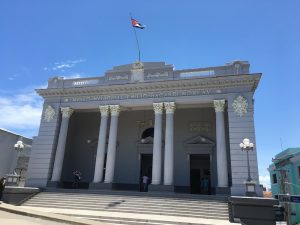 Read more
Read moreIn 1912, Emilio Bacardí Moreau, a son of the founder of the Bacardí Rum Company, launched a personal expedition to Europe and the Middle East for the purchase of numerous antiquities, in particular an authentic Egyptian mummy (and original sarcophagus) ...
- “IN SEARCH OF AN ANCIENT LAND”
 Read more
Read moreConceived a full decade before the discovery of Tutankhamen’s tomb, the display of a real Egyptian mumy and related funerary artifacts surely bolstered the prestige and financial security of the historical museum as its founder Emilio Bacardí Moreau (1844-1922) intended. ...
- Cuba’s Very Public Telephones
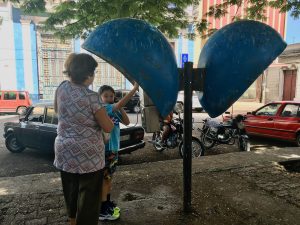 Read more
Read moreCould the notable absence of a booth in telephones that Cuban engineers designed during the 1970s and 1980s say something about the general absence of privacy in a socialist society under Communist rule? I might never have considered that question ...
- A Cuban-Mexican Joint Venture
 Read more
Read moreAmidst the collapse of the Soviet bloc between 1989-1993, the Cuban state shocked the world (and perhaps its own citizens the most) by announcing the legalization of neoliberal-style investment between agencies of the Cuban government and foreign companies. ETECSA, a ...
- UF History Students in Cuba, 2014
 Read more
Read moreUnlike most tourists to El Morro fortress overlooking Havana harbor, our class did not confine our exploration of its history to the Spanish colonial era when it was a built. Instead, we discussed how its walls had been witnesses to ...
- The Revolution…in cars
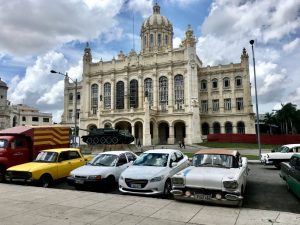 Read more
Read moreParked in front of Cuba’s historic (and still not entirely renovated) Presidential Palace, these cars reflect the grindingly slow pace of change that has characterized Cuba’s one-party state since Fidel Castro’s movement took power in 1959. Unable to import new ...
- Symbol of Splendor and Squalor
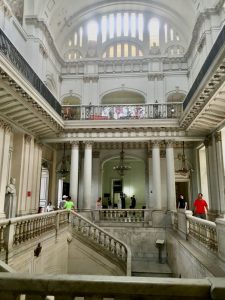 Read more
Read moreCuba’s Presidential Palace was built during the presidency of Mario García Menocal (1913-1921) and enabled by a massive surge in sugar prices caused by the collapse of beet sugar production in Europe and armies’ reliance on sugar for soldier rations ...
- The Revolution That Might Have Been
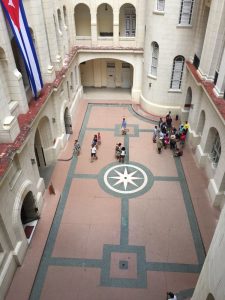 Read more
Read moreThe interior patio of the Presidential Palace remains marked by one indelible historical moment, more than possibly any other: a nearly successful commando assault and an assassination attempt on the life of dictator Fulgencio Batista by the University of Havana, ...
- Batista’s Fascination with Abe Lincoln
 Read more
Read moreDuring his many years at the command of Cuba’s government (1934-1944, 1952-1958), General Fulgencio Batista regularly expressed that his greatest admiration for the United States was embodied in its paramount liberator, President Abraham Lincoln. Obviously, for anyone familiar with Lincoln’s ...
- Batista’s Office
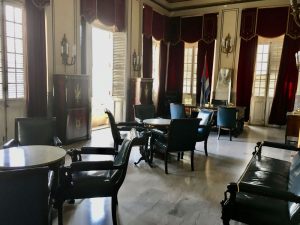 Read more
Read moreGoing to Cuba’s Presidential Palace since it re-opened after partial restoration and the curatorial revision of many of its exhibits offered the chance to view the office of Cuba’s former presidents. For Cuban history buffs, this was particularly exciting because ...
- Contradictions of Leadership
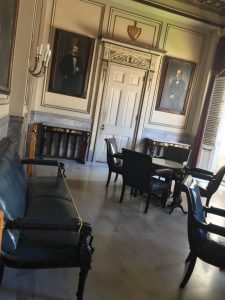 Read more
Read moreWith Martí at his back, a seated Cuban president would have gazed upon two portraits of Cuba’s early national figures. To the left hangs the image of Carlos Manuel de Céspedes, a sugar planter who defied all expectations when he ...
- Legend of the Solid-Gold Telephone
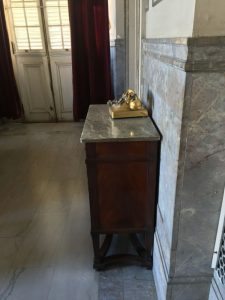 Read more
Read moreA day after surviving a student-led commando team’s assassination attempt, the dictator Fulgencio Batista famously received a congratulatory visit from US Ambassador Arthur Gardner. The latter brought a solid-gold telephone as a personal gift from the American-owned Cuban Telephone Company, ...
- Strolling El Bulevar San Rafael
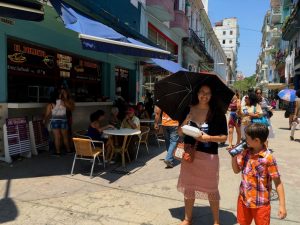 Read more
Read moreIn Cuba, a “boulevard” is a wide street of shops open only to foot traffic, no cars. In 2016, when I took this picture, the bustling, relatively clean Bulevar San Rafael that stretches from Galeano Street to El Prado and ...
- Pizza…Cuba’s Post-Soviet National Dish?
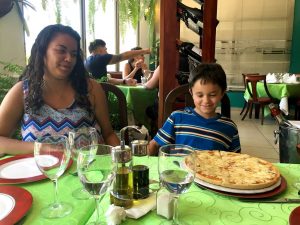 Read more
Read moreAs anyone who spent time in Cuba after the collapse of the Soviet Union can attest, pizza—made from a modicum of ingredients and (euphemistically speaking) a unique variety of “cheese”—became nearly ubiquitous in the 1990s. Originally costing only ten pesos ...
- Freshly Roasted Peanuts
 Read more
Read moreWith the legal return of small-time businesses to the economy in the 1990s, freshly roasted peanuts became a standard staple of snack vendors on Cuba’s urban streets. Although many foreigners failed to divine what they are, historians (and often older ...
- Dining with Cimarrones
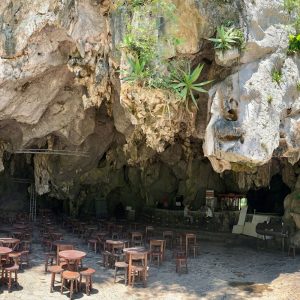 Read more
Read moreConspicuously hidden by a natural cave entrance in a lush valley north of Viñales, Pinar del Río, this ambitious state-run restaurant is called Palenque de los Cimarrones. True to its name, the eatery serves as a faux fortification inhabited by ...